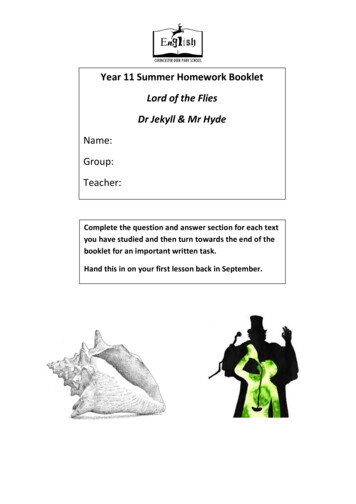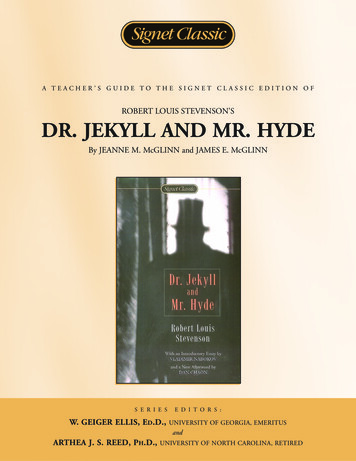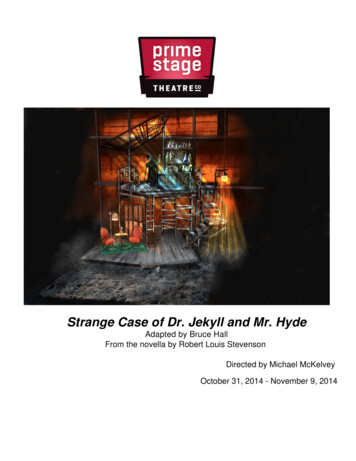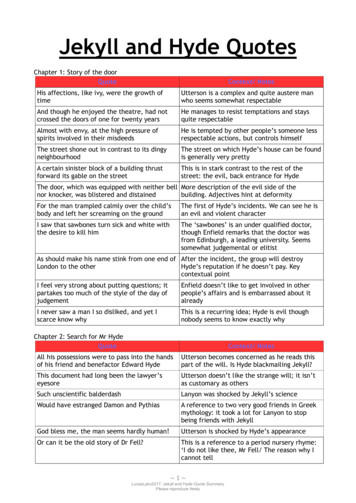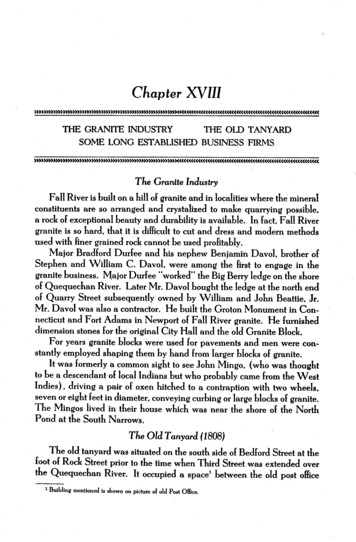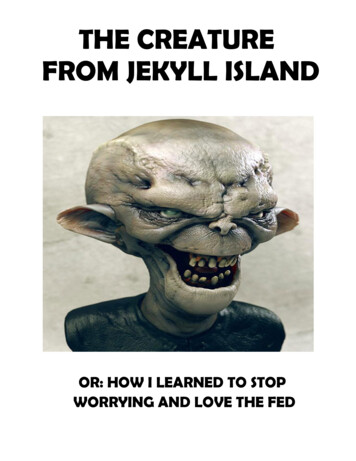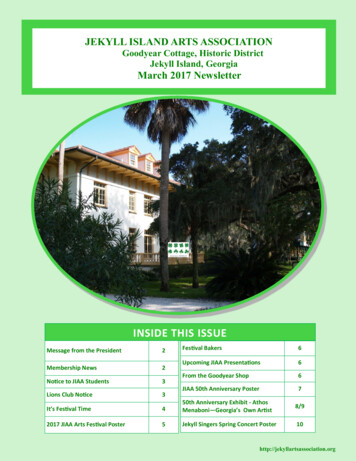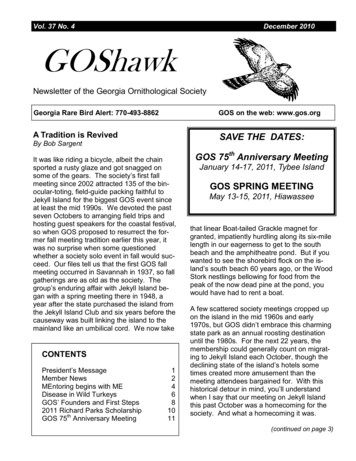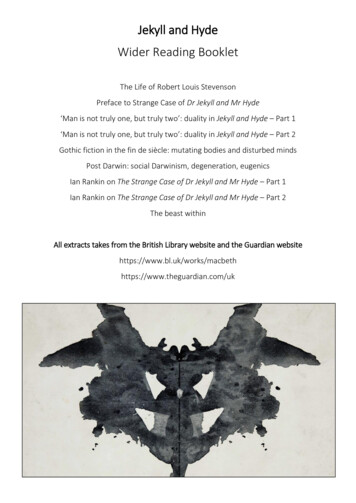
Transcription
Jekyll and HydeWider Reading BookletThe Life of Robert Louis StevensonPreface to Strange Case of Dr Jekyll and Mr Hyde‘Man is not truly one, but truly two’: duality in Jekyll and Hyde – Part 1‘Man is not truly one, but truly two’: duality in Jekyll and Hyde – Part 2Gothic fiction in the fin de siècle: mutating bodies and disturbed mindsPost Darwin: social Darwinism, degeneration, eugenicsIan Rankin on The Strange Case of Dr Jekyll and Mr Hyde – Part 1Ian Rankin on The Strange Case of Dr Jekyll and Mr Hyde – Part 2The beast withinAll extracts takes from the British Library website and the Guardian theguardian.com/uk
Extracts from The Life of Robert Louis StevensonSource: https://www.bl.uk/people/robert-louis-stevensonThe Scottish novelist, essayist, and poet Robert Louis Stevenson is perhaps most famous for his ‘boys’ book’ TreasureIsland. Born in Edinburgh, he was the son of the distinguished engineer Thomas Stevenson. He suffered from chronicbronchial disease, and spent much of his childhood alone in bed spinning stories: his memories informed A Child’sGarden of Verses (1885).Trained first as an engineer and then as a lawyer, he was always more interested in writing, training himself byimitating (‘playing the sedulous ape’) to authors he admired and then, from 1873, publishing essays and working onplays. Conflicted with his father over both religion and earning a living, he led a bohemian life in Edinburgh and tookwalking tours in Britain and abroad. Among his delightful travel accounts are his canoe journey An Inland Voyage(1878) and walking tour Travels With a Donkey in the Cevennes (1879).In 1876, he met the love of his life, the lively American Fanny Van de Grift Osbourne. In 1879, he followed her toCalifornia, where they married after Fanny’s divorce; The Silverado Squatters (1884) is the story of their honeymoon inan abandoned mining camp. Stevenson’s fame grew with the publication of Treasure Island (1883), and in 1884 heand Fanny moved to Bournemouth, where they lived for three years. During this period he wrote Strange Case of DrJekyll and Mr Hyde and Kidnapped (both published 1886).Worsening health led Stevenson to settle with his family in Samoa in 1890, where he lived in great style, and wroteCatriona (1893), a sequel to Kidnapped. He died from a brain haemorrhage while working on Weir of Hermiston(1896).
Extracts from Preface to Strange Case of Dr Jekyll and Mr HydeSource: nge-case-of-dr-jekyll-and-mr-hydeIn 1880 Robert Louis Stevenson and his friend W E Henley wrote a play called Deacon Brodie, or the Double Life. Itproduction on the London stage was unsuccessful. Stevenson’s wife, Fanny, in her 1905 preface to Strange Case of DrJekyll and Mr Hyde, states that the Deacon Brodie story, together with ‘a paper [Stevenson] read in a French scientificjournal on sub-consciousness’, provided ‘the germ of the idea that afterwards developed into the play’, and later theshort story Markheim, and the novel Strange Case of Dr Jekyll and Mr Hyde.There is a widely-told story that Fanny woke Stevenson from a dream at the point of the first transformation of Jekyllinto Hyde, thus causing an argument between them. Stevenson subsequently wrote the first draft of the story in threedays; Fanny’s criticism was that, by using Hyde merely as a tool for the morally bad Jekyll, the story missed thepotential to be a powerful allegory. This led Stevenson to burn his original manuscript, later rewriting it, againsupposedly in three days. Both Fanny and her son insisted on the speed of the rewriting, Fanny stating ‘The amount ofwork this involved was appalling’.In Stevenson’s essay A Chapter on Dreams (1888) he writes that he ‘had long been trying to write a story on thissubject, to find a body, a vehicle, for that strong sense of a man’s double being which must at times come in upon andoverwhelm the mind of every thinking creature’. He does not talk about burning the Jekyll and Hyde manuscript, butmentions another story, The Travelling Companion, which he burned because it had been supplanted by Jekyll andHyde. In the same year Stevenson told a reporter from the San Francisco Examiner that the novel had been drafted inthree days and written in six weeks.
Extracts from ‘Man is not truly one, but truly two’: duality in Jekyll and Hyde – Part 1Source: of-dr-jekyll-and-mr-hydeRobert Louis Stevenson’s The Strange Case of Dr Jekyll and Mr Hyde (1886) is a late-Victorian variation on ideas firstraised in Mary Shelley’s Frankenstein (1818). Stevenson’s monster, however, is not artificially created from stitchedtogether body parts, but rather emerges fully formed from the dark side of the human personality. In the story DrJekyll, an admired member of the professional Victorian middle-classes, conducts a series of scientific experimentswhich unleash from his own psyche the ‘bestial’ and ‘ape-like’ Mr Hyde (ch. 10). Gothic fiction had examined the ideaof the sinister alter ego or double before on many occasions but Stevenson’s genius with Jekyll and Hyde was to showthe dual nature not only of one man but also of society in general. Throughout the story, respectability is doubled withdegradation; abandon with restraint; honesty with duplicity. Even London itself has a dual nature, with its respectablestreets existing side-by-side with areas notorious for their squalor and violence.Viewed on a simple level, Dr Jekyll is a good man, much admired in his profession. Mr Hyde, meanwhile, is evil. He is amurderer; a monster who tramples upon a small girl simply because she happens to be in his way. On a deeper level,however, the comparison is not merely between good and evil but between evolution and degeneration. Throughoutthe narrative Mr Hyde’s physical appearance provokes disgust. He is described as ‘ape-like’, ‘troglodytic’ and ‘hardlyhuman’ (ch. 2). As Mr Enfield, a well-known man about town and distant relative of Jekyll’s friend Mr Utterson,observes ‘There is something wrong with his appearance; something displeasing, something downright detestable’ (ch.1).Some 15 years before Jekyll and Hyde, Charles Darwin had published The Descent of Man (1871), a book in which heconcluded that humankind had ‘descended from a hairy, tailed quadruped’ which was itself ‘probably derived from anancient marsupial animal’. Going back even further, Darwin hypothesised that these stages of evolution had beenpreceded, in a direct line, by ‘some amphibian-like creature, and this again from some fish-like animal’. Such anightmarish biological lineage that denied the specialness of humans, feeds into many late-Victorian Gothic novels.Dracula’s ability to transform into the shape of a wolf or a bat is one example, while Dr Moreau’s experiments uponthe hapless animals on his island as he attempts a barbaric form of accelerated evolution is another. Stevenson’sportrayal of Hyde works in a similar fashion. Mr Hyde is regarded as physically detestable but perhaps only because hesubconsciously reminds those he encounters of their own distant evolutionary inheritance. When Dr Jekyll’s medicalcolleague, Dr Lanyon, witnesses Hyde transform back into Jekyll, the knowledge that the ugly, murderous beast existswithin the respectable Victorian scientist sends him first to his sick-bed, and then to an early grave.
Extracts from ‘Man is not truly one, but truly two’: duality in Jekyll and Hyde – Part 2Source: of-dr-jekyll-and-mr-hydeThe depiction of Dr Jekyll’s house was possibly based on the residence of famous surgeon John Hunter (1728–1793),whose respectable and renowned house in Leicester Square in the late 18th century also had a secret. In order toteach and to gain knowledge about human anatomy, Hunter required human cadavers, many of them supplied by‘resurrection men’ who robbed fresh graves. These were brought, usually at night, to the back entrance of the house,which had a drawbridge leading to the preparation rooms and lecture-theatre. The front aspect of Dr Jekyll’s housepresents a ‘great air of wealth and comfort’ (ch. 2). Meanwhile Mr Hyde, soon after we first encounter him, is seenentering a building which displays an air of ‘prolonged and sordid negligence’ (ch.1). The twist is that the reputablefront and the rundown rear form two sides of the same property. Stevenson is not only making the point that therespectable and the disreputable frequently exist in close proximity, but also that a respectable façade is no guaranteeagainst dark secrets lurking within. In a similar fashion, the seemingly decent Mr Enfield, a friend of the lawyer MrUtterson, first encounters Hyde while ‘coming home from some place at the end of the world, about three o’clock of ablack winter morning’ (ch. 1). Exactly where Mr Enfield has been, and what he has been up to, are never made clearbut it sounds far from innocent. Throughout the book the people and events that initially seem innocent andstraightforward become dark and sinister when viewed more closely.Just as the differing appearances of Dr Jekyll and Mr Hyde play upon the theories emerging from Charles Darwin’swork, so their differing personalities explore contemporary debates about moral behaviour and the possible pluralityof human consciousness. By literally splitting the consciousness of Dr Jekyll into two – the decent side that attempts,and largely succeeds, in suppressing desires that run contrary to the dictates of society; and the amoral side that runsriot in an attempt to gratify animal desire – Stevenson explores in a heightened fashion the battles played out in everyone of us. As Dr Jekyll observes ‘I saw that, of the two natures that contended in the field of my consciousness, even ifI could rightly be said to be either, it was only because I was radically both’ (ch. 10). Through Hyde, the respectable DrJekyll is freed from the restraints imposed by society – ‘my devil had been long caged, he came out roaring’ (ch. 10). Inhis confession at the end of the book, Jekyll observes that, ultimately, he will have to choose between being Dr Jekyllor Mr Hyde. To become the latter would mean giving up on noble aspirations and being ‘forever despised andfriendless’. (ch. 10) To become Jekyll, however, means giving up the sensual and disreputable appetites he can indulgeas Hyde. In spite of the curious circumstances of his own case it is, as the melancholy Jekyll observes, a struggle anddebate ‘as old and commonplace as man’ (ch. 10).
Extracts from Gothic fiction in the fin de siècle: mutating bodies and disturbed mindsSource: e-Victorian society was haunted by the implications of Darwinism. The ideas outlined in Charles Darwin’s On theOrigin of Species (1859) and The Descent of Man (1871) had by the 1880s and 1890s been assimilated, initially by thescientific community and then by much of the general public. For many, the balance between ‘faith’ and ‘doubt’ hadtipped disturbingly in favour of the latter, and questions about the origins, nature and destiny of humankind hadbecome matters for science, rather than theology to address. The final chapter of The Descent of Man contains apassage in which Darwin concludes that humans are ‘descended from a hairy, tailed quadruped’ which, via severalintermediary stages, had itself evolved ‘from some amphibian-like creature, and this again from some fish-like animal’.Such a nightmarish lineage in which human evolution was portrayed as a disturbing variation on the theme ofFrankenstein’s monster, with humanity being assembled from assorted disparate earlier versions, perhaps lies behindthe descriptions of Mr Hyde as ‘ape-like’ and ‘troglodytic’ in Stevenson’s Jekyll and Hyde; the implication is that thebrutal and uncivilised Hyde is somehow a reversion to a more primitive stage of human development; a ghastlyevolutionary precursor who stands in a direct genetic line behind the eminently respectable Dr Jekyll.Evolution also raised doubts in another sense. Initially it appeared logical that evolution would always lead to physicaland mental improvement with weaker and less-useful characteristics being eradicated over time; however, it wassoon recognised that this was not necessarily the case. Evolution is a mechanistic process with no guiding hand orultimate goal and therefore, it was argued, in certain circumstances degeneration into less-complex forms was just aslikely as progress into more complex ones.The influential Italian criminologist Cesare Lombroso (1835–1909) had argued that the ‘born criminal’ could berecognised by certain physical characteristics – unusually sized ears, for example, or asymmetrical facial features;particularly long arms or a sloping forehead. Mr Hyde’s ‘troglodytic’ appearance in Jekyll and Hyde marks him out as acriminal and as someone who is unacceptable in polite society. The fact that Dr Jekyll, who is highly respected, and MrHyde who is a social outcast happen to be one and the same person, allows Stevenson to simultaneously acceptLombroso’s theory (in the depiction of Hyde) and refute it (in the appearance of Jekyll). This implication that thecriminal could lurk behind an acceptable public persona, and that appearances might provide no real indication of thepersonality within, rendered Jekyll and Hyde a particularly disturbing work during the late 1880s as Jack the Rippercarried out his attacks in Whitechapel.
Extracts from Post Darwin: social Darwinism, degeneration, eugenicsSource: csMany Victorians recognised in evolutionary thinking a vision of the world that seemed to fit their own socialexperience. The scale of change during the 19th century, and the impact on people’s lives of industrialisation,urbanisation and technological innovation, was unprecedented. The idea of a ‘struggle for existence’ that was centralto Darwin’s theory of biological evolution was a powerful way to describe Britain’s competitive capitalist economy inwhich some people became enormously wealthy and others struggled amidst the direst poverty.Darwin’s evolutionary ideas helped many Victorians to imagine a dynamic world of progress. It seemed to fit perfectly,for a period of time at least, an image of Britain at the forefront of an industrialised and wealthy modern world inwhich man had definitively tamed nature for his own ends. Towards the end of the 19th century, however, theories ofevolution were the basis of fears of social, racial and cultural degeneration and decline. Evolution was countered byfrightening examples of ‘devolution’. Some of the most popular fiction of this period – including Robert LouisStevenson’s Strange Case of Dr Jekyll and Mr Hyde (1886), Henry Rider Haggard’s She (1887) and H G Wells’s The TimeMachine (1895) – explored scenarios of frightening devolution. Stevenson’s erudite, gentlemanly and rather boredJekyll turns into the beastly Hyde, who is cruel, lustful and murderous. Hyde’s squat, ape-like body, his dark, hairyhands, and his energy and appetite all signal his ‘primitive’ state.Fears that modern European civilisation was on the brink of disaster and decline were, for some at least, given credenceby the new literature and art. A German writer, Max Nordau, used scientific and evolutionary language to condemnmuch late 19th-century European music and writing. His book, Degeneration, translated in 1895, attacked a long listof writers, poets, dramatists, artists and composers, including Oscar Wilde. Wilde’s downfall from the height of hisfame in the same year, when he was tried and imprisoned for ‘gross indecency’ seemed to illustrate Nordau’s case.All manner of biological arguments about degeneration were extended to debate about social and cultural life in thelate 19th century, as major European societies were buffeted by volatile economic conditions. Degeneration becamean influential idea and a favourite trope for writers. However, notions of degeneration did not supersede otherevolutionary ideas, but became a part of the extraordinary imaginative resource that Darwin’s theory – unwittingly, onhis part – provided.
Extracts from Ian Rankin on The Strange Case of Dr Jekyll and Mr Hyde – Part 1Source: rankin-dr-jekyll-mr-hydeThe notion of a ‘Jekyll-and-Hyde’ character has become a lazy way of describing someone when they do somethingcontrary to their normal nature. But that’s not quite what Dr Henry Jekyll does. Rather, he consciously searches for achemical that will allow him to separate out the two sides to his nature. He is fascinated by the duality of man andwants to explore his darker side. Resolute and determined, eventually he succeeds. But his evil self becomes strongerover time, until it threatens to extinguish Jekyll altogether. The doctor has played with fire and he’s burning from theinside.Sadly, we’ll never know the thrill experienced by this explosive book’s original audience. Dr Jekyll and Mr Hyde is awork of suspense, but we all know the twist these days, don’t we? So why do we still read the story? Well, it’s writtenwith great economy, tension and wit. I know few books so concise that pack such an emotional punch. It’s also acomplex narrative: Jekyll himself figures only as a friend of the other characters and narrators – right up until therevelation provided by his ‘confession’. We start the book in the company of two gentlemen called Utterson andEnfield. They are out walking, but Enfield has a story to tell. It concerns a grotesque incident and its aftermath. Thestory links the thuggish and mysterious Edward Hyde to the wealthy and urbane Henry Jekyll. Utterson and Enfield arein no doubt: their friend is being blackmailed. But Hyde has a stronger hold on Jekyll than this, as Utterson willeventually discover.The tale originally came to its author in a dream. Robert Louis Stevenson had always trusted to ‘brownies’ – meaninghis daydreams and nightmares. He felt that stories and characters were being channelled to him from elsewhere. As ayoung man his fantasy life had been kept in check. He had grown up in a family of engineers and was himself destinedfor a career in the law. He lived with his family in a large house in Edinburgh’s ‘New Town’ (constructed to a rational,geometric design in the late 18th century). But the population of the New Town had decamped from the squalid,overcrowded and downright dangerous ‘Old Town’ (the stretch of Edinburgh between Castle Rock and the Palace ofHolyrood). Stevenson was captivated by the Old Town, and would tiptoe out of the house when everyone else wasasleep, climbing the steep slope towards drink and debauchery. He knew fine well that there were two sides toEdinburgh’s character – he’d known it since childhood. In his bedroom there stood a wardrobe constructed by WilliamBrodie, and young Stevenson’s nanny would tell him the story of Brodie, who had been a respected citizen by day buthousebreaker by night. Here was the duality of Man – not only in the figure of Brodie but also apparently built into theconstruction of the city itself – light and dark, the rational and the savage.
Extracts from Ian Rankin on The Strange Case of Dr Jekyll and Mr Hyde – Part 2Source: rankin-dr-jekyll-mr-hydeStevenson suffered ill-health all his life, and was being dosed with an experimental drug at the time when his‘brownies’ assailed him with the story of the good doctor and his evil other self. It must have struck Stevenson that itmight be a yarn about his own attraction to the less savoury side of life. Maybe self-preservation led him to set thenovel in London rather than Edinburgh. On the other hand, London was perfect. It had been the home of a Scots-borndoctor called John Hunter. Hunter was known in all the right circles. He was married to a patron of the arts who wouldgive grand parties at their home in Leicester Square. But if you continued through the house you came to Hunter’ssurgery. You might also be shown his vast (and growing) collection of weird and wonderful specimens. And eventually,you’d find yourself in the cramped accommodation used by his students, beyond which a door led out into a narrowalley off what is now Charing Cross Road. This was where, at dead of night, the grave-robbers arrived with freshdeliveries of cadavers. John Hunter did like his little experiments.When you read Dr Jekyll and Mr Hyde you will be struck by the similarities. (Jekyll himself purchased such a propertyfrom the heirs of a great medical man.) For a tale steeped in fantasy and the macabre, this is a novel with its rootsfirmly planted in a recognisable world – so much so, in fact, that when Jack the Ripper began his work, the publicbegan to suspect that Hyde himself might be real. And remember . Jack, too, was reputed to be a medical man.As a writer, Stevenson wanted to explore the various facets of human nature. Was civilisation just a very thin veneer?Did you dare to scratch its surface and reveal the truth beneath? We are all capable of committing evil acts – look atthe atrocities meted out in wartime. Killers talk about the ‘red mist’ that descends, then lifts, leaving them wonderinghow they could have done such terrible deeds. Religious believers talk of ‘possession’. Psychopaths can appear to bejust like you and me for the most part of their lives, but then suddenly flip, before flipping back again.This is an important book because it discusses a very basic problem which is still (and forever) with us – how can we dosuch terrible things to each other? Jekyll feels hidebound in his own skin, made to comply with the rigid conventionsof his class and society. Hyde frees him from this, but the sensation of liberation becomes addictive. It is no accidentthat Hyde is described as being much younger than Jekyll. Jekyll himself is a man of 50, regretting times past andopportunities missed. The folly of youth – that sense of possibility and invincibility – is regained when he becomesEdward Hyde. This book, then, is a morality tale as well as a stark warning. It’s also every bit as claustrophobic, creepyand chilling as when it first saw the light of day over a century ago.
Extracts from The beast withinSource: ekyll-mr-hyde-stevensonDr Jekyll and Mr Hyde belongs to everyone who has ever referred to themselves in the third person, or cursed theirown ‘split personality’, or praised their ‘better nature’. The poet Hugo Williams has compressed the essence into asingle line - ‘God give me strength to lead a double life’ - a plea to be in two places at once, not necessarilylegitimately, without the inconvenience of a guilty conscience. Stevenson’s respectable physician Henry Jekyll appearsto have had a similar desire, though his appeal was not to the deity but the pharmaceutical cabinet, with disastrousresults.Strange Case of Dr Jekyll and Mr Hyde (the definite article is missing from the original title) was written in about sixweeks in the autumn of 1885. It was Stevenson’s response to a request from the publisher Charles Longman for aghost story for the Christmas number of Longman’s Magazine, in which he gave readers a taste of his best authors.The legend put about by RLS’s stepson Lloyd Osbourne has it that he wrote a draft in three days, after beingawakened from a dream, then threw it into the fire when his wife Fanny, Lloyd’s mother, complained that he had‘missed the allegory’. After a brief period of reflection, Stevenson wrote it all out again, ‘in another three days offeverish industry’.Lloyd was a charming teller of tales about his stepfather, but not a reliable one. Letters make it plain that Stevensonspent at least six weeks on the revision. And even if an early version really was burned - ‘imagine my feelings as wesaw those precious pages wrinkling and blackening and turning into flames’, Lloyd wrote - there still exist two fulldrafts of the novella.Fanny, his wife, however, was right to stress the importance of the missing element. It clearly is an allegory: in real life,people do not split into separate selves, with different bodily characteristics and ages (Hyde is notably smaller andyounger than Jekyll). But an allegory of what? Stevenson’s mother Margaret, who lived for three years after the deathof her son in Samoa in 1894, was touched to learn that the story had been interpreted by a Church of Scotlandminister as a parable on the wages of sin, and preached as a sermon from the pulpit. Stevenson’s first biographer,Graham Balfour (1901), tells us that it was also ‘made the subject of leading articles in religious newspapers’.Stevenson might have smiled indulgently at his acceptance by the kirk many years after he had fallen out with hisfather over fundamental religious differences, but he would have disapproved of the simplistic reading of his story as alesson on the perils of straying from the path of righteousness.There are many other allegorical interpretations of the story. Elementary Freudianism sees Jekyll as embodying the ego(rational), Hyde the id (instinctive). Jekyll has been seen as a drunk, a drug addict, a pederast, a closet homosexual. Inan excellent introduction to the Edinburgh University Press edition of the novella, Richard Dury ranges over a varietyof possible readings, noting that of several ‘socially condemned activities’ that Hyde is associated with, ‘veiledallusions to homosexuality are particularly frequent’. The double life of Jekyll and Hyde can be seen as parallel to ‘thenecessarily double life of the Victorian homosexual’. Even though Stevenson may not have intended leaving them,there are suggestive markers throughout the text: the suspected blackmail of Jekyll by his ‘young man’, his ‘favourite’;the ‘very pretty manner of politeness of Sir Danvers Carew’ when approached in the street - terms that may havedenoted forbidden liaisons to a Victorian readership.
Jekyll and Hyde Wider Reading Booklet The Life of Robert Louis Stevenson . Ian Rankin on The Strange Case of Dr Jekyll and Mr Hyde – Part 2 The beast within All extracts takes from the British Library website and the Guardian website . Island. Born in Edinburgh, he was th
